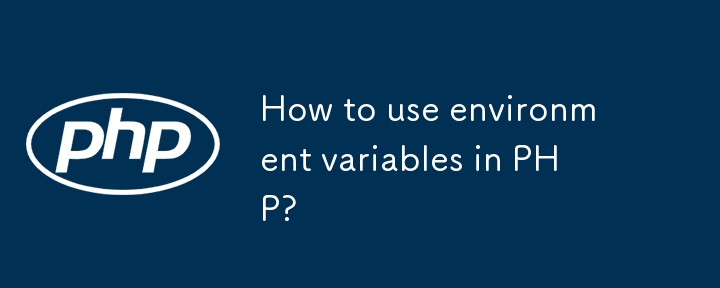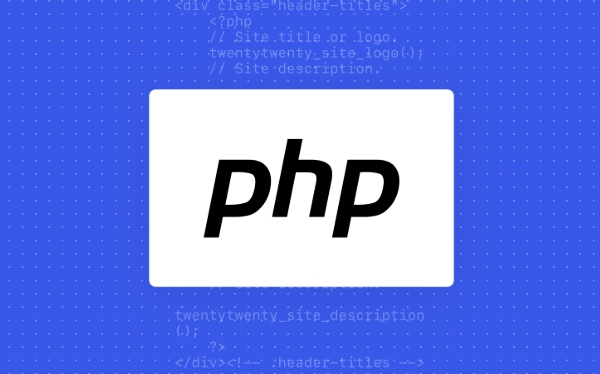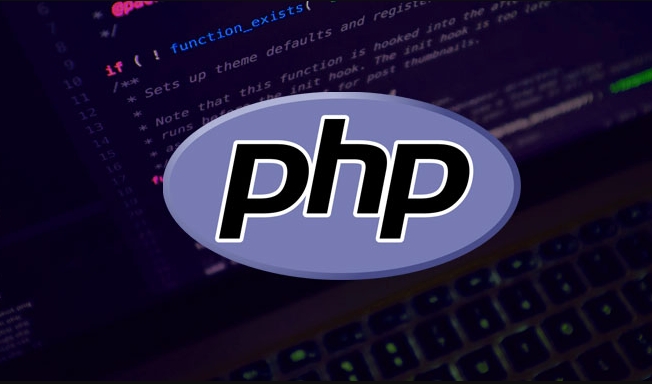There are three main ways to use environment variables in PHP: through server configuration, .env file or operating system settings, and then read in the code. First, use $_SERVER['VAR_NAME'] or getenv('VAR_NAME') to get variables, but pay attention to whether the variable is passed correctly; second, create a .env file in the root directory of the project and manually parse and load it, which is suitable for development environment; third, configure environment variables in Apache or Nginx, such as Apache uses the SetEnv directive, and Nginx uses the fastcgi_param parameter to pass variables. This method is more stable and suitable for production environments.

It is not difficult to use environment variables in PHP, but many people tend to get confused in several different ways at the beginning. Simply put, you can set environment variables through server configuration, .env file, or operating system level, and then read them in PHP code.

The following common scenarios and methods can help you clarify how to use them.

Get environment variables from $_SERVER and getenv()
PHP provides two common ways to get environment variables: $_SERVER hyperglobal array and getenv() function.
-
$_SERVER['VAR_NAME']is the most common way to work in most deployment environments. -
getenv('VAR_NAME')can also get variables, but thevariables_orderconfiguration may be enabled under certain SAPIs (such as FPM).
Note:

- If you see a variable that appears in
phpinfo()but$_SERVERdoes not, it may be that it is not being correctly passed to PHP. - Some hosting platforms (such as Laravel Forge or Envoyer) will automatically inject
.envvariables into$_SERVER.
Manage local environment variables using .env files
Although PHP does not support .env files natively, many frameworks (such as Laravel and Symfony) integrate related functions. You can also implement a simple version manually.
The steps are as follows:
- Create a
.envfile in the project root directory, with the content like this:DB_HOST=localhost DB_USER=root DB_PASS=secret
- Then read and parse the file in PHP, which can be handled with simple functions:
$lines = file('.env', FILE_IGNORE_NEW_LINES | FILE_SKIP_EMPTY_LINES); foreach ($lines as $line) { if (strpos(trim($line), '#') === 0) continue; list($key, $value) = exploit('=', $line, 2); putenv(trim($key) . '=' . trim($value)); }
This method is suitable for the development environment, but it is recommended to use the server to configure incoming variables to be more secure when it is online.
Setting environment variables in Apache or Nginx
If you have server permissions, it is more stable to configure environment variables directly in the web server.
Apache example:
Add in .htaccess or virtual host configuration:
SetEnv DB_HOST localhost SetEnv DB_USER root
Nginx example:
In the configuration file:
fastcgi_param DB_HOST localhost; fastcgi_param DB_USER root;
These variables are passed to PHP and can be obtained through $_SERVER or getenv() .
Basically these are the methods. Different project structures and deployment methods will affect how you choose, but the core logic is the same: first set variables, then read and use them. The key is to choose the right way according to the environment, and don't forget about security and maintainability.
The above is the detailed content of How to use environment variables in PHP?. For more information, please follow other related articles on the PHP Chinese website!

Hot AI Tools

Undress AI Tool
Undress images for free

Undresser.AI Undress
AI-powered app for creating realistic nude photos

AI Clothes Remover
Online AI tool for removing clothes from photos.

Clothoff.io
AI clothes remover

Video Face Swap
Swap faces in any video effortlessly with our completely free AI face swap tool!

Hot Article

Hot Tools

Notepad++7.3.1
Easy-to-use and free code editor

SublimeText3 Chinese version
Chinese version, very easy to use

Zend Studio 13.0.1
Powerful PHP integrated development environment

Dreamweaver CS6
Visual web development tools

SublimeText3 Mac version
God-level code editing software (SublimeText3)
 PHP Variable Scope Explained
Jul 17, 2025 am 04:16 AM
PHP Variable Scope Explained
Jul 17, 2025 am 04:16 AM
Common problems and solutions for PHP variable scope include: 1. The global variable cannot be accessed within the function, and it needs to be passed in using the global keyword or parameter; 2. The static variable is declared with static, and it is only initialized once and the value is maintained between multiple calls; 3. Hyperglobal variables such as $_GET and $_POST can be used directly in any scope, but you need to pay attention to safe filtering; 4. Anonymous functions need to introduce parent scope variables through the use keyword, and when modifying external variables, you need to pass a reference. Mastering these rules can help avoid errors and improve code stability.
 How to handle File Uploads securely in PHP?
Jul 08, 2025 am 02:37 AM
How to handle File Uploads securely in PHP?
Jul 08, 2025 am 02:37 AM
To safely handle PHP file uploads, you need to verify the source and type, control the file name and path, set server restrictions, and process media files twice. 1. Verify the upload source to prevent CSRF through token and detect the real MIME type through finfo_file using whitelist control; 2. Rename the file to a random string and determine the extension to store it in a non-Web directory according to the detection type; 3. PHP configuration limits the upload size and temporary directory Nginx/Apache prohibits access to the upload directory; 4. The GD library resaves the pictures to clear potential malicious data.
 Commenting Out Code in PHP
Jul 18, 2025 am 04:57 AM
Commenting Out Code in PHP
Jul 18, 2025 am 04:57 AM
There are three common methods for PHP comment code: 1. Use // or # to block one line of code, and it is recommended to use //; 2. Use /.../ to wrap code blocks with multiple lines, which cannot be nested but can be crossed; 3. Combination skills comments such as using /if(){}/ to control logic blocks, or to improve efficiency with editor shortcut keys, you should pay attention to closing symbols and avoid nesting when using them.
 How Do Generators Work in PHP?
Jul 11, 2025 am 03:12 AM
How Do Generators Work in PHP?
Jul 11, 2025 am 03:12 AM
AgeneratorinPHPisamemory-efficientwaytoiterateoverlargedatasetsbyyieldingvaluesoneatatimeinsteadofreturningthemallatonce.1.Generatorsusetheyieldkeywordtoproducevaluesondemand,reducingmemoryusage.2.Theyareusefulforhandlingbigloops,readinglargefiles,or
 Tips for Writing PHP Comments
Jul 18, 2025 am 04:51 AM
Tips for Writing PHP Comments
Jul 18, 2025 am 04:51 AM
The key to writing PHP comments is to clarify the purpose and specifications. Comments should explain "why" rather than "what was done", avoiding redundancy or too simplicity. 1. Use a unified format, such as docblock (/*/) for class and method descriptions to improve readability and tool compatibility; 2. Emphasize the reasons behind the logic, such as why JS jumps need to be output manually; 3. Add an overview description before complex code, describe the process in steps, and help understand the overall idea; 4. Use TODO and FIXME rationally to mark to-do items and problems to facilitate subsequent tracking and collaboration. Good annotations can reduce communication costs and improve code maintenance efficiency.
 Quick PHP Installation Tutorial
Jul 18, 2025 am 04:52 AM
Quick PHP Installation Tutorial
Jul 18, 2025 am 04:52 AM
ToinstallPHPquickly,useXAMPPonWindowsorHomebrewonmacOS.1.OnWindows,downloadandinstallXAMPP,selectcomponents,startApache,andplacefilesinhtdocs.2.Alternatively,manuallyinstallPHPfromphp.netandsetupaserverlikeApache.3.OnmacOS,installHomebrew,thenrun'bre
 How to access a character in a string by index in PHP
Jul 12, 2025 am 03:15 AM
How to access a character in a string by index in PHP
Jul 12, 2025 am 03:15 AM
In PHP, you can use square brackets or curly braces to obtain string specific index characters, but square brackets are recommended; the index starts from 0, and the access outside the range returns a null value and cannot be assigned a value; mb_substr is required to handle multi-byte characters. For example: $str="hello";echo$str[0]; output h; and Chinese characters such as mb_substr($str,1,1) need to obtain the correct result; in actual applications, the length of the string should be checked before looping, dynamic strings need to be verified for validity, and multilingual projects recommend using multi-byte security functions uniformly.
 Learning PHP: A Beginner's Guide
Jul 18, 2025 am 04:54 AM
Learning PHP: A Beginner's Guide
Jul 18, 2025 am 04:54 AM
TolearnPHPeffectively,startbysettingupalocalserverenvironmentusingtoolslikeXAMPPandacodeeditorlikeVSCode.1)InstallXAMPPforApache,MySQL,andPHP.2)Useacodeeditorforsyntaxsupport.3)TestyoursetupwithasimplePHPfile.Next,learnPHPbasicsincludingvariables,ech






